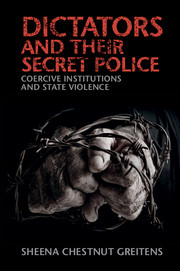Book contents
- Frontmatter
- Dedication
- Contents
- List of tables and fi gures
- A note on romanization
- Acknowledgments
- PART I THE PUZZLE AND THE ARGUMENT
- PART II THE ORIGINS OF COERCIVE INSTITUTIONS
- PART III COERCIVE INSTITUTIONS AND STATE VIOLENCE
- PART IV EXTENSIONS AND CONCLUSIONS
- 9 Extending the argument: coercion outside East Asia
- 10 Conclusion
- Appendix: A note on sources
- Index
- Miscellaneous Endmatter
10 - Conclusion
from PART IV - EXTENSIONS AND CONCLUSIONS
Published online by Cambridge University Press: 05 August 2016
- Frontmatter
- Dedication
- Contents
- List of tables and fi gures
- A note on romanization
- Acknowledgments
- PART I THE PUZZLE AND THE ARGUMENT
- PART II THE ORIGINS OF COERCIVE INSTITUTIONS
- PART III COERCIVE INSTITUTIONS AND STATE VIOLENCE
- PART IV EXTENSIONS AND CONCLUSIONS
- 9 Extending the argument: coercion outside East Asia
- 10 Conclusion
- Appendix: A note on sources
- Index
- Miscellaneous Endmatter
Summary
This book has developed the first rigorous, comparative, and empirically documented theory of the origins and operation of authoritarian coercive institutions. Coercion is central to theories of the state and to our intuitive understanding of dictatorship, yet political scientists have largely overlooked the variation that exists across the institutions that manage domestic surveillance, repression, and violence. The strategies of repression and patterns of violence that these regimes employ also differ in ways not fully explainable by existing theories. Simply put, authoritarian coercive institutions are not all alike, and neither is the violence that they produce. Today, when political developments in non-democratic regimes shape the fate of billions of individuals and shift the contours of global politics, it is important to understand why. This concluding chapter briefly reviews the main findings of the book, draws out the implications of the work for scholarship and policy, and identifies questions raised by the findings that suggest directions for future research.
MAIN FINDINGS
The first half of this book examined the origins of coercive institutions, and explored the reasons for variations in their structure and social composition. It posited that autocrats face a “coercive dilemma”: a fundamental tradeoff between optimizing their internal security apparatus to deal with a popular threat, or coup-proofing it to defend against elite rivals. Coup-proofing against elite threats typically creates an internally fragmented security force, drawn from narrow and exclusive segments of society. Managing popular unrest, on the other hand, calls for a unitary, non-fragmented apparatus with broadly embedded, socially inclusive intelligence networks. Chapters 3, 4, and 5 demonstrated that autocrats construct coercive institutions based on whichever threat they perceive to be dominant at the time they come to power. Institutional inheritance and external influence are not immaterial, but they are rarely, if ever, decisive when it comes to coercive institutional design – not surprising since the fate of the autocrat himself rests on the performance of these institutions.
The second half of the book examined the effect of variations in coercive institutional structure and social composition on patterns of state violence. Chapters 6, 7, and 8 demonstrated that different coercive organizational characteristics give rise to predictable variations in state violence.
- Type
- Chapter
- Information
- Dictators and their Secret PoliceCoercive Institutions and State Violence, pp. 292 - 306Publisher: Cambridge University PressPrint publication year: 2016



